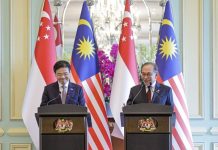
Hong Kong’s annual imports and exports fell more than 10 per cent in February, in the worst decline since early 2013 given global economic headwinds and a slump in trade with a slowing China. Total imports in February fell 10.1 per cent to HK$237.6 billion (US$30.63 billion) from HK$264.2 billion a year earlier, government data showed on Tuesday.
Exports fell 10.4 per cent to HK$204.5 billion from the same period a year earlier. This was the largest decline for both imports and exports since February 2013, in what a government spokesman attributed to increased headwinds from weak global demand that had “put a significant drag on the export performance of many other Asian economies”.
Hong Kong’s external trading environment “will still be subject to considerable downside risks in the near term,” the statement added, including a slowing global economy, normalisation of US monetary policy and heightened geopolitical tensions in different parts of the world.
Imports to Hong Kong from China in February fell 18.2 per cent, while the value of exports to China fell 6.4 per cent. China earlier reported that exports to Hong Kong had fallen 13.1 per cent in February to 14.6 billion yuan (US$2.26 billion).
There have been concerns of massive fake trade invoicing from China to Hong Kong, following a massive discrepancy in China’s reported exports to Hong Kong in December, and the value of goods recorded by the financial hub for the same period.
MIDF Research views that February trade performance for Hong Kong is volatile at best, varying from year to year since trade data was recorded.
Case in point, according to the research house, exports jumped by 20.8% in February 2012, plunging by 18.3% in the year after and rose by 6.8% in February 2014.
The trade performance is heavily influenced by the timing of the Chinese New Year Festival and then there is growing concern for fake trade invoicing from China to Hong Kong which could have distorted the trade data further.
“Despite the non-availability of seasonally adjusted data, having one would not help much in dissecting the volatile trade performance without identifying the exact difference of festive season timing and the quantum of the forged trade between the two neighbouring countries.”
MIDF Research believes that, nevertheless, Hong Kong’s trade data is useful in gauging Malaysia’s trade performance for February which is due for release next week.
Hong Kong is an important trade partner to Malaysia, being the 6th biggest exports destination. Exports to Hong Kong in 2015 reached RM36.9 billion or approximately 4.7% of total exports value. In February, data from Hong Kong recorded imports from Malaysia fell for the eight consecutive months by 6.1% but eases from a contraction of 11.4% in the month earlier.
“However, we opine that the February’s exports performance for Malaysia could be worse than January due to heavy slump of China’s trade performance and seemingly reversal effect of Ringgit appreciation.”
























